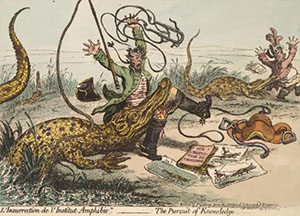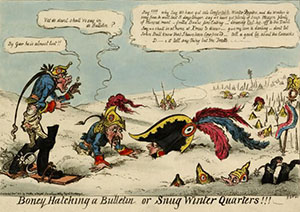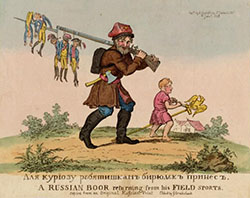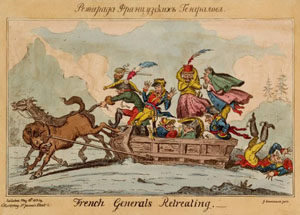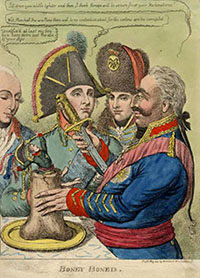Introduction to the Web Collection
by H. Saska
While British satires comprise the bulk of images in this collection, we are proud to have representative prints from countries, including France, Germany, and Russia. Such a diverse gathering of images and ideas automatically raises the question of how these prints can constitute a cohesive collection. Yet, amassed together, this collection of satiric prints exemplifies a language of popular imagery that transcends national borders. Moreover, these popular images are "popular" in the truest sense of the word in that they targeted a wide audience of men and women drawn from all orders of society. Authored by many different hands, the satirical prints in this collection develop a consistent iconography to vilify Napoleon I, attacking his legitimacy as ruler of France and as the embodiment of the French Revolution. Such images remind the viewer that the military campaigns of the Napoleonic wars were bloody battles that depleted national resources of men and goods. Among the campaigns that receive the greatest amount of attention in satire are the Egyptian campaign, which occurred at the beginning of the wars, and the Russian front, which occurred towards the end of Napoleon's reign. Significantly, satires of both episodes focus on the lack of regard Napoleon had for the health and the lives of the French soldiers under his command. Napoleon's despotic tendencies are connected to his megalomaniac pursuit of empire, which flies in the face of his goal of spreading the values of the French Revolution and enriching the French nation. These images charge that Napoleon's desire for self-preservation and self-promotion cause him to willingly abandon his troops and save his own hide. Napoleon is so power-hungry and bloodthirsty that he is willing to sacrifice his own citizens; behavior that is diametrically opposed to the ideal of the paternal head of state.
Satires of the Egyptian campaign in this collection are characterized by images that depict the poisoning of diseased French soldiers in Jaffa by French doctors. Reports of this incident sent back to Europe struck a particular chord in England, where satirists issued prints depicting Napoleon giving incredulous doctors the order to murder his soldiers. Such horrific scenes are contrasted by James Gillray's humorous Sketches of Egypt, a series of caricatures claiming to be French dispatches intercepted by British ships. Gillray's engravings imagine awkward French engineers and zoologists — sent to record the architectural wonders and to tame the "crocodiles" — in hilarious situations. This lighthearted approach to the French occupation of Egypt belies the grave disaster of the plague that awaited French soldiers in their attempt to control Northern Africa, the unseen enemy of disease overtook French troops. Yet, as British satirists are quick to demonstrate, the real danger arrives in the figure of Napoleon who willingly murders his sick and abandons the rest.
Abandonment in the face of disaster is also the theme of these print satires of battles on the Russian front. Just as the Egyptian satires claimed to offer a corrected version of events, the Russian satires correct French dispatches, which claimed immanent success. George Cruikshank's Snug Winter Quarters depicts Napoleon dictating one such letter from his escape sled. While the dictation Napoleon gives is full of reassurance that French troops are safely and comfortably settled for the winter, the scene Cruikshank provides is a travesty of Napoleon's dispatch. Bodies of French soldiers litter the frozen expanse; those that remain alive are skeletal figures with only scraps of clothing. These desperate scavengers are shown eating horsemeat and, in some cases, ravaging the bodies of their comrades. Russian satires in the provide another reaction to the war on the northern front and balance those made by British satirists. Like their British counterparts, Russian satirists focused on the ill preparedness of the French soldiers. Often, in these images, robust Russian peasants are contrasted with thin and "delicate" French soldiers, foppish types best suited to drawing rooms of Paris rather than the harshness of winter in the Russian countryside.
An excellent example of the fluidity of satiric sentiment can be found in an exchange of images and ideas between the Russian satirist Tenebenev and George Cruikshank. Using the British figure Little Boney, a well-established guise for Napoleon, Tenebref extends Napoleon's satirical characteristics to all French soldiers. In two of Tenebref's caricatures now in the Hay's collection, hearty Russian peasants are shown cheerfully dispatching tiny French soldiers. In one image a stout, Russian figure uses a pitchfork to load French soldiers into a "dung cart." In another a peasant returns from the day's hunt with a string of French soldiers hanging from his musket like a brace of hares. Cruikshank, in translating the Russian caricatures into English versions, also translated the figures into characters English audiences would better recognize. To do so, Cruikshank took the finely delineated figures in the Russian prints and exaggerated their features to a greater extent. He also dramatized the gestures made by the figures and re-sized the image for reproduction on the larger sized sheets favored by English clientele. Cruikshank's "Englished" versions of the prints maintain the original Russian title, perhaps to impress the foreignness of the image on the purchaser, or perhaps to indicate that the scourge of Napoleon was felt across Europe. Although Cruikshank's versions of Tenebref's print satires were altered for British purchasers, the essential bite of the image remains indicating that British audiences found the Russian prints timely and valid.
Viewing Satires
As mentioned above, print caricatures and satires reached a large audience of viewers. In Britain, as in many other European countries, most consumers of such prints lived in cities — the very areas where these images were produced. In particular, London print shops attempted to woo prospective customers by placing the latest offerings in their windows. As several images in this collection demonstrate, this practice successfully brought buyers into the shop and also brought an audience into being as passersby were compelled to stop in front of the displays and examine the images. Significantly, London print shops, like their continental counterparts, did not limit themselves to the sale of one type of print. As a result, it was not uncommon for a portrait of a leading politician, say Charles James Fox or William Pitt, to rub shoulders with a satire of the same subject. Viewers were thus invited to compare the sitter's 'official' portrait with his caricature.
The public appeal of print satires and caricatures extended beyond the exchanges between the images and viewers in the shop and in front of the shop window. Unlike political satires in the modern era, satires were not typically incorporated into newspapers. While in some cases, satires were included as inserts among pages of texts, and is the German journal London und Paris, and the British periodical The Satirist, most satires were purchased and displayed in domestic spaces for the purposes of entertainment. Often these sheets were pasted into albums, mounted on the walls, or fixed onto folding screens. Even in the home, the experience of viewing satires was shared with others. Nowhere is this more evident than in the volumes of Caricatures to be Lent for the Evening produced by S.W. Fores, albums that could be rented and brought into the home or club for an evening's entertainment. Some such sheets can be found in this collection and are easily identified by the inscription on the bottom edge of the sheets. In addition to their use in domestic settings, satires were also purchased and displayed in taverns, coffeehouses and in clubs. Frequently engravers incorporated the various viewing venues into the representations themselves, such that the events depicted in the satires would unfold in locations like the tavern or the street.
While most satires remained far too expensive for the lower orders, a hierarchy in pricing and quality opened up the market for those in the upper and middle tiers of society. For example, where hand-colored satires made from plates engraved by James Gillray sold at Hannah Humphrey's establishment for a shilling, cheaper images, and in some cases piracies, could be found in the less reputable shops like those run by Samuel Fores and Thomas Tegg. The shops of Fores and Tegg also printed second run editions of engraved plates. When plates became worn, or the material out-dated, the plates were often sold to second (or third) tier publishers for republication. Many second-run editions of prints were altered by the new owners, who scratched the name of the original publisher off the plate and replaced it with their own name.
One way for engravers and for publishers to maintain financial rights, and rights of publication, was by engraving the original date of publication on the plate. In addition, the location of the print shop was inscribed along with the engravers signature, and/or the name of the person who supplied the 'conceit' for the plate. Always tongue-in-cheek, well known satirists and engravers like George Cruikshank, James Gillray and Thomas Rowlandson employed the academic convention of signing the plate with "designit," "sculpsit" or "fecit," Latin terms used to indicate authorship and the particular roles of engraver. Although the leading satirists in the London print world managed to make a modest living from their labor, the production of satires was most profitable for the publisher. In fact, the publisher, not the artist, owned rights to reproduction and dissemination of the impressions. Thus, the alterations made by second-run publishers, specifically the re-inscription of name and date, designated their ownership of the plate.
While British publishers enjoyed relative freedom of the press, their continental counterparts were not so lucky. Image production in France was closely monitored by the government, and images had to be registered and deposited in the central copyright office. As evidenced by the Hay's collection, French satires and caricatures of Napoleon were not widely produced until the Napoleon had been removed from power. At this time, images critical of Napoleon were readily available in the French capitol — as were those lamenting his exile. Despite the strict regulations imposed on French printing concerns, British prints managed to infiltrate the market in Paris and in other European capitols. In Germany and in Russia, where Napoleon was the villain du jour, vitriolic satires produced in native presses attacked the French upstart Emperor with gusto.
Since many of the satires in this collection feature individuals and events that have faded into obscurity, the images may appear quaint and outmoded to the twenty-first-century eye. We may find ourselves asking, "What's so funny?," when confronted with representations that seem particularly violent or opaque. In my descriptions of the prints I have attempted to explain the humor and relevance of these images. It has been my intent to show that in order for the satires to do their "work" they must be viewed and understood as a group. Napoleon, for example only became "Little Boney" after several satirists reproduced Gillray's vision of the man as a stunted child.
Finally, I hope that the visitor's use of this website will enable exploration of the contextual and visual juxtapositions these images suggest in themselves. Surprisingly, the relative freedom of perusal and navigation afforded by our current computer technologies is not entirely unlike the experience of the eighteenth and nineteenth-century print owners who arranged these images in their albums on their library shelves, or hung them on walls.
Within this mode of viewing the visitor can study and enjoy these images in a number of ways. For example, images like Cruikshank's can be compared to the original Russian examples. In other cases, various states or copies of images can be compared and images with similar motifs can be juxtaposed. The browser's ability to focus in on a particular aspect of a print with precision and clarity approximates examining the image under a microscope. While some nuances are lost, the scholar is able to digitally compare signatures, states, or, more easily decipher eighteenth- and early-nineteenth-century handwriting. This is one way in which the scanned images manage to preserve the materiality of the sheets. The ability to compare and re-order the images is a further advantage of viewing these images online. Now, viewing these images continues to be a pleasure for modern audiences. I hope visitors to this site will experience the excitement of discovery we have enjoyed when uncovering images and grouping them together.


